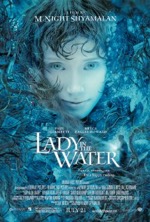Lady in the Water (PG-13)

Starring: Paul Giamatti
July 2006
“Shyamalan’s Scary Tale Succeeds by Taking Risks”
The word “narf” effortlessly plopped out of director M. Night Shyamalan’s mouth one evening as he was telling his children a bedtime story. That homespun fairytale soon became the creative fodder for Shyamalan’s latest thrill-fest, Lady in the Water. From the start, Shyamalan made it clear that the movie—an unconventional love story filled with mythological creatures—would be a radical departure from his other films.
The opening narration, conveyed in a series of petroglyphs, provides the particulars of the movie’s myth: Once every eon, an ancient race of humans send an envoy from their water world to meet with their surface-dwelling brethren in an attempt to ignite a great awakening among humans. A water nymph (narf) must find the “vessel”—a person of unique vision—that will usher in the era of peace. Despite repeated attempts throughout history, every narf ambassador has failed in her peace-fostering mission because “man doesn’t listen very well.”
As the story opens, we’re introduced to Cleveland Heep (Paul Giamatti), a tortured soul who manages an apartment complex in Philly. Cleveland’s mundane existence as handyman, exterminator and peacekeeper brings him into contact with many of the building’s colorful tenants, including the Hispanic couple and their five daughters, the Asian college student and her controlling mother, the Indian writer (Shyamalan) and his nagging sister, the eccentric jock who only exercises the right side of his body, the African American father who excels at crossword puzzles and his insightful son, the quartet of freethinking beer buddies and the newest tenant, a haughty movie critic.
It takes a while for Shyamalan to establish all of his characters and their relationships to each other, but when Story the narf (Bryce Dallas Howard) surfaces in Cleveland’s pool, the plot kicks into high gear and a first-rate mystery begins to unfold. Story quickly identifies the “vessel,” but determining the supporting players—the guild, the guardian and the symbolist—proves more problematic. Cleveland and his tenants, now bound by a common purpose, must protect Story from an aggressive, wolf-like creature called a skrunt until the giant eagle swoops down and carries her to freedom.
It all sounds a bit hokey on paper, but Shyamalan does a masterful job of balancing character and plot with the fantastical. In an effort to mitigate the moments of stark terror (which are far fewer and less severe here than in his other movies), Shyamalan has employed more humor this time, which is just a natural byproduct of the multi-layered and multi-cultural characters that populate his story. One of the ongoing sources of amusement is the Asian mother’s reticence to share the narf’s origin tale with Cleveland. At one point, Cleveland must act like a child and have milk and cookies on the woman’s couch in order to receive a short lesson in narf mythology. The arrogant critic also provides unexpected comic relief; his jaded commentary on romance movies and his miscalculation of the danger he’s in at the movie’s climax is highly entertaining.
There’s no doubt that Shyamalan can select stars (like Willis and Gibson) for his projects, but here he’s handpicked an amazing cast, each of whom shines in his or her own way and serves a different function in the director’s visionary yarn. Howard’s fair complexion and ethereal visage lends itself perfectly to the otherworldly Story. The fact that Story doesn’t know a lot about what’s going on makes the movie that much more riveting and satisfying. Giamatti works magic in the title role; his stuttering everyman is extremely likable and accessible—there’s something in his timbre and delivery that reminds me of a younger Richard Dreyfuss. As a reluctant leader, carrying around a Santa-sized sack of guilt from his wife’s death, Cleveland finds a measure of heroism within himself when his paternal instinct kicks in and drives him to protect Story at all costs. Cleveland is captivating throughout and is an excellent character study.
Some, undoubtedly, will find Shyamalan’s avant-garde resolution unpalatable; but you can hardly fault him for breaking with the “big twist ending” motif that’s marked all of his other films. Here, he tries something different, and, for better or worse, I applaud his efforts. Though Lady in the Water is far inferior to The Sixth Sense, it’s the most human Shyamalan tale to date—by assembling an excellent ensemble of intriguing characters, the auteur has delivered one of the most unique and refreshing movies to come along in quite some time. So, whether or not you buy into narfs and skrunts, know that Lady in the Water has inaugurated a new film genre…high-art fairytale.
Rating: 3